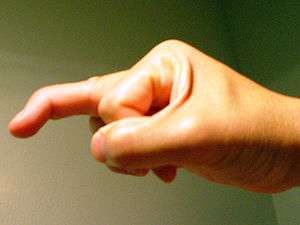Mallet finger
| Mallet finger | |
|---|---|
 | |
| Mallet finger is indicated in the middle finger in this photo. The tip of the finger bends downwards while the rest of the finger stays straight. | |
| Classification and external resources | |
| Specialty | rheumatology |
| ICD-10 | M20.0 |
| ICD-9-CM | 736.1 |
| DiseasesDB | 31230 |
| eMedicine | article/1242305 |
In medicine, mallet finger, also baseball finger,[1] dropped finger, dolphin finger, "Virgin Finger", "Hannan Finger", "PLF Finger" and (more generally) extensor tendon injury, is an injury of the extensor digitorum tendon of the fingers at the distal interphalangeal joint (DIP).[2] It results from hyperflexion of the extensor digitorum tendon, and usually occurs when a ball (such as a softball, basketball, volleyball or dodgeball), while being caught, hits an outstretched finger and jams it, creating a ruptured or stretched extensor digitorum tendon.
Mallet finger can be caused by a blunt force on the DIP. Patients who are diagnosed with mallet finger have an inability to extend their finger and experience pain and numbness. Depending on how severe the injury is, the patient can be prescribed medication in order to prevent infection. Also, most mallet finger injuries can be treated without surgery.
Once a patient has been struck with mallet finger, ice should be applied immediately and the patient’s arm should be elevated above the heart in order to reduce blood circulation to the fingers. This is because this reduces inflammation, which causes further damage. The patient should be seen by a doctor within a week after the injury. Treatment options include surgery or putting the finger in a Mallet splint for 6 to 8 weeks or extension block k-wire for 4 weeks. The splint allows the tendon to return to normal length, if the finger is bent during these weeks the healing process must start all over again. Surgery is used to reattach the tendon and is usually performed within a week of the injury.
Patients that present with mallet finger will have pain at the DIP joint, and will be unable to extend the joint. It should be determined via radiograph if the extensor digitorum tendon has avulsed from the phalanx, which will require surgical intervention to reattach the tendon and should be done within 10 days of the injury. Surgical treatment is used when the mallet finger presents as an open injury or if the bony mallet involves more than 30% of the articular surface of the joint. If passive extension cannot be achieved, surgery will put the finger in a neutral position and drill a wire through the DIP to the PIP, forcing immobilization and eliminating patient compliance for re-injury.
- X-ray showing fracture at the insertion of the extensor tendon
- A mallet finger without an associated fracture
- An example of a splint for mallet finger.
- Lateral view a splint for mallet finger.
References
- ↑ "Mallet Finger (Baseball Finger)". American Academy of Orthopaedic Surgeons. Retrieved 2008-10-21.
- ↑ "Mallet Finger". General Practice Notebook. Retrieved 2008-04-23.
3. "Tendon avulsion injuries of the distal phalanx.". Clin Orthop Relat Res. 445: 157–68. Apr 2006. doi:10.1097/01.blo.0000205903.51727.62. PMID 16601414.
4. Mallet Finger http://www.aafp.org/afp/2006/0301/p810.html
5. Kellicker, Patricia. Finger Extensor Tendon Injury: Mallet Finger; Boutonniere Deformity. Rep. no. HL445937. N.p.: n.p., n.d. Consumer Health Complete. Web. 23 Nov. 2013.
6. " Mallet Finger (Baseball Finger)." Mallet Finger (Baseball Finger). American Society for the Surgery of the Hand, 2011. Web. 23 Nov. 2013.
External links
- Mallet Finger - eMedicine.com
- Mallet Finger - edoctor.co.in